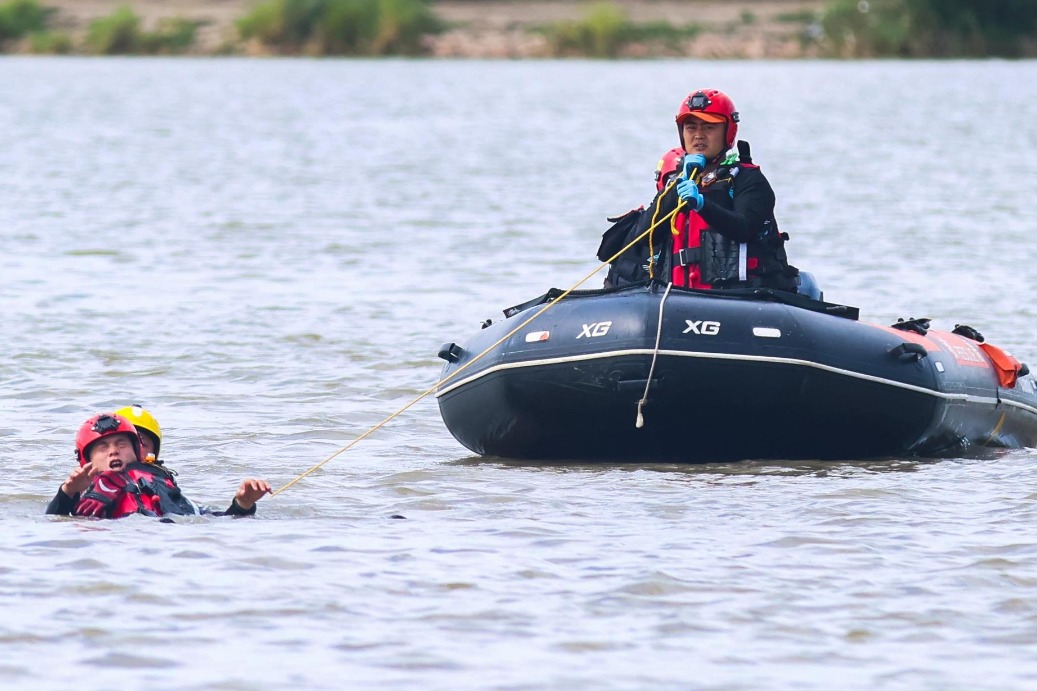China's Antarctic research achieves several firsts in latest expedition


China's latest Antarctic expedition achieved multiple firsts, including launching active-source seismic exploration in the inland regions for the first time, which filled a gap in the country's high-precision seismic detection capabilities in the area.
The seismic detection technology reached an internationally advanced level, researchers said on Tuesday at a news briefing after the expedition, which was organized by the Ministry of Natural Resources. The icebreaker Xuelong, or Snow Dragon, has returned to Shanghai, marking the near completion of the mission.
The team also conducted a joint experiment using wideband hyperspectral microwave radiometers, providing critical data for research on polar ice cap melting, subglacial lakes and water systems, and sea level changes.
In another first, the team performed long piston coring for sediment samples in the Amundsen Sea, recovering an 8.67-meter sediment core. Scientists said the core will help unravel the ancient ocean and environmental evolution of the region.
Additionally, researchers optimized the design of subglacial buoys, improving their efficiency in recovery and deployment. As a result, a buoy deployed in the mission set a record for the longest observation period by a Chinese polar expedition, collecting data for 1,407 days.
"Through the innovation of technical methods and the large-scale application of domestically developed equipment, our three-dimensional observation and monitoring capabilities from land, sea and air were comprehensively improved during this 41st Chinese Antarctic expedition," said Wang Jinhui, the expedition leader and chief scientist.
Wang added that the team's research into climate change's impact on the Antarctic ecosystem had yielded significant results.
The expedition also resulted in unexpected animal observations. Researchers collected a year's worth of penguin habitat data in Enderby Land and Amanda Bay for the first time, providing crucial information on penguin behavior and interannual habitat variations.
"Moreover, southern bottlenose whales were observed during such expeditions for the first time," Wang said. "Throughout the journey, a total of 560 whale groups were recorded, including 1,300 individuals across 14 species. Variations in whale habitats serve as an important indicator of global warming."
The expedition team also engaged in international cooperation, organizing a joint autumn cruise in the Ross Sea region. The United States, Australia, South Korea, the United Kingdom, New Zealand, Malaysia and Thailand were among the participants.
Additionally, Chinese researchers collaborated with counterparts from Russia, Brazil, India, South Africa and other countries to conduct research on Antarctic biological ecology. Two Thai scientists were invited to study microplastics at China's Great Wall Station, one of the country's five research bases in Antarctica.
"The expedition set records in operational time and regional coverage, providing experience for future large-scale, high-intensity, interdisciplinary polar investigations," said Long Wei, deputy director of the Chinese Arctic and Antarctic Administration.
"These efforts provide strong support for China and the international community to conduct in-depth research on the rapid changes in Antarctica, its ecological response, global climate change and Antarctic governance," he added.
The mission included 516 members from 118 domestic and international institutions and marked the second time China has conducted a three-ship segmented expedition in Antarctica.
Xuelong departed from Guangzhou, Guangdong province, on Nov 1, traveling more than 27,000 nautical miles over 159 days. The Yongsheng vessel left Zhangjiagang, Jiangsu province, on Nov 20, completing its mission on Jan 23 after a 65-day journey covering nearly 11,000 nautical miles.
Meanwhile, China's icebreaker Xuelong 2, or Snow Dragon 2, is conducting a joint expedition in the Ross Sea, the first time China has undertaken such a mission. Researchers said the expedition will provide scientific data to better understand sea-ice-air interaction, ecosystem processes, biological survival strategies and carbon burial in the region's autumn low-dark season.
Snow Dragon 2 is expected to return to Shanghai in June.
- Mainland warns Lai over pro-independence remarks
- Shanghai Book Fair unveils new initiatives ahead of official opening
- China allocates 100m yuan for post-disaster recovery in flood-hit Guangdong
- Notice calling for a halt to minors participating in food delivery services sparks debate
- 1st anniversary of Badain Jaran World Heritage status celebrated
- Former Guangxi official gets death with reprieve





































